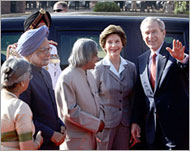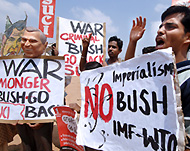US and India reach nuclear accord
India and the United States have sealed a civilian nuclear pact, the centrepiece of President George Bush’s visit to the South Asian nation.

The pact marks a major breakthrough for India as it allows it to access American atomic technology and fuel to meet its soaring energy needs – provided the US Congress gives its approval.
It is also expected to allow atomic trade between India and other nuclear powers if the Nuclear Suppliers Group – an informal group of nations that controls global nuclear transactions – follows suit by lifting curbs on New Delhi.
India was placed under international sanctions after conducting nuclear tests in 1974 and 1998.
India and the US have also agreed to boost bilateral economic ties and co-operation in space travel, agriculture and health, officials on both sides said.
Bad example?
Under the nuclear deal, India has agreed to separate its civilian and military nuclear programmes and place the civilian plants under international inspections.
The deal was approved in principle last July when India’s Prime Minister Manmohan Singh visited Washington. It ran into trouble due to differences over India’s plan to separate its military and civilian atomic plants.
 |
|
Surveys point to largely positive |
Some US experts feel that the deal sets a bad example for countries such as Iran and North Korea, which have signed the nuclear 1972 Non-Proliferation Treaty (NPT), unlike New Delhi.
Pakistan, which has atomic weapons, has also refused to sign the NPT.
The NPT grants China, the United States, Russia, France and
Britain status as nuclear weapons states, but bars other
signatory countries from having such weapons.
Bush and his aides have said the nuclear deal is only one component of a wider strategic relationship.
Bush is scheduled to meet business leaders to improve investment and trade ties and will also visit the southern city of Hyderabad, known for its mix of cutting-edge industries and agricultural and pharmaceutical research, during his three-day trip.
Economic ties
US-India economic ties are growing rapidly. Last year, US exports to India jumped by more than 30%, compared with 20% growth in Indian exports to the US.
Bilateral merchandise trade amounted to nearly $27 billion, seen by officials as way below the potential of the two economies.
 |
|
Muslim and leftist groups have |
Bush kicked off the official leg of his visit on Thursday by inspecting a ceremonial guard in New Delhi.
The US president said: “I’ve never been to India before and I’ve been looking forward to this trip for a long time. I am looking forward to working with the president and prime minister to foster a very important relationship.”
Anti-Bush protests
Meanwhile, thousands of Muslim and leftist protesters gathered in the Indian capital in protest against Bush’s visit.
Dozens of politicians stood on the steps of the country’s national parliament building chanting “Bush go back!“ and “Down with Bush!“
Hannan Mollah, an MP from the Communist Party of India, said: “Our one slogan is: ‘Bush go back!’ We’re saying this because he is the biggest killer of humanity in the 21st century. He has killed in Afghanistan, he has killed Iraqis and now he is bent on killing Iranians.“